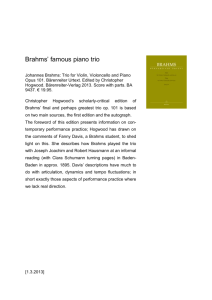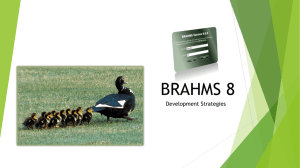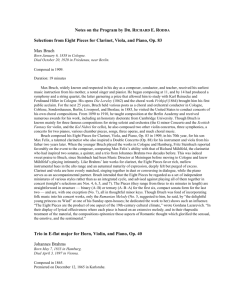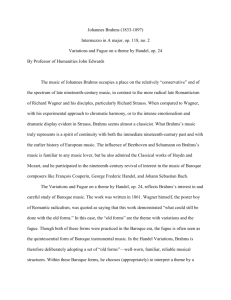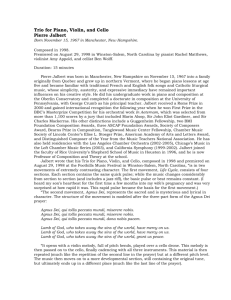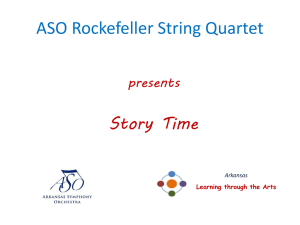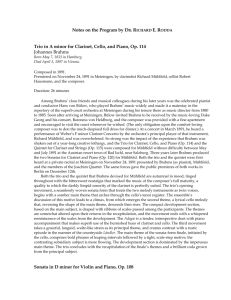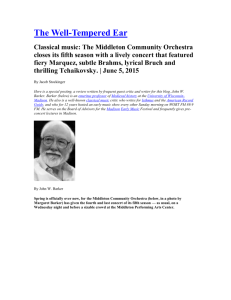noteson the program - New York Philharmonic
advertisement
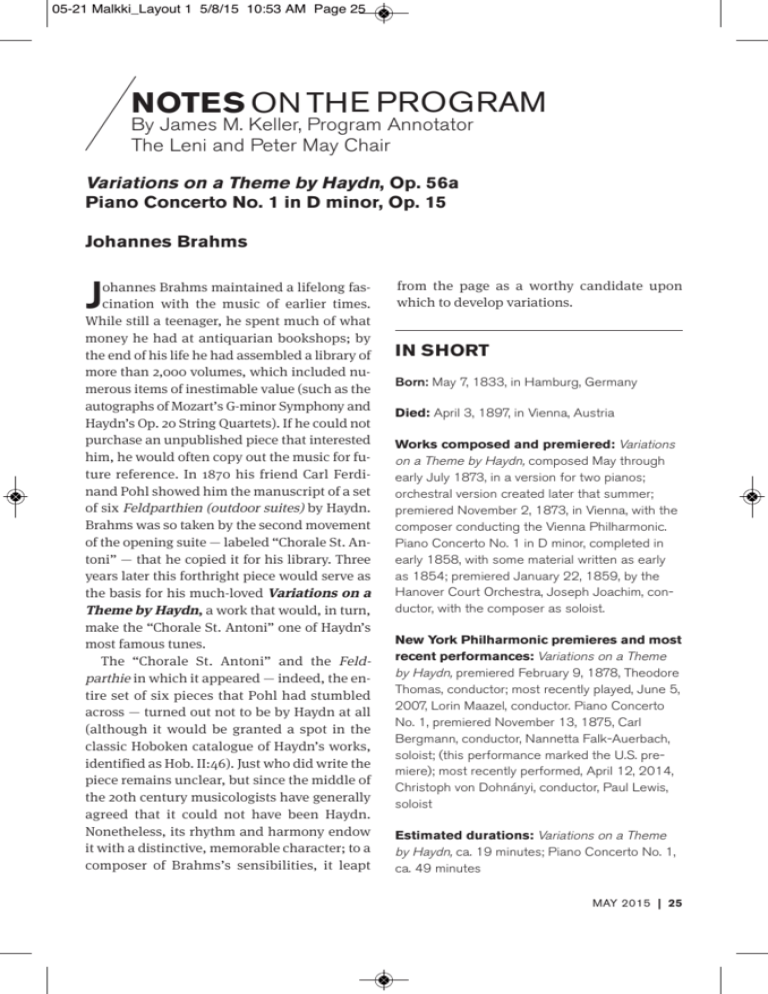
05-21 Malkki_Layout 1 5/8/15 10:53 AM Page 25 NOTES ON THE PROGRAM By James M. Keller, Program Annotator The Leni and Peter May Chair Variations on a Theme by Haydn, Op. 56a Piano Concerto No. 1 in D minor, Op. 15 Johannes Brahms J ohannes Brahms maintained a lifelong fascination with the music of earlier times. While still a teenager, he spent much of what money he had at antiquarian bookshops; by the end of his life he had assembled a library of more than 2,000 volumes, which included numerous items of inestimable value (such as the autographs of Mozart’s G-minor Symphony and Haydn’s Op. 20 String Quartets). If he could not purchase an unpublished piece that interested him, he would often copy out the music for future reference. In 1870 his friend Carl Ferdinand Pohl showed him the manuscript of a set of six Feldparthien (outdoor suites) by Haydn. Brahms was so taken by the second movement of the opening suite — labeled “Chorale St. Antoni” — that he copied it for his library. Three years later this forthright piece would serve as the basis for his much-loved Variations on a Theme by Haydn, a work that would, in turn, make the “Chorale St. Antoni” one of Haydn’s most famous tunes. The “Chorale St. Antoni” and the Feldparthie in which it appeared — indeed, the entire set of six pieces that Pohl had stumbled across — turned out not to be by Haydn at all (although it would be granted a spot in the classic Hoboken catalogue of Haydn’s works, identified as Hob. II:46). Just who did write the piece remains unclear, but since the middle of the 20th century musicologists have generally agreed that it could not have been Haydn. Nonetheless, its rhythm and harmony endow it with a distinctive, memorable character; to a composer of Brahms’s sensibilities, it leapt from the page as a worthy candidate upon which to develop variations. IN SHORT Born: May 7, 1833, in Hamburg, Germany Died: April 3, 1897, in Vienna, Austria Works composed and premiered: Variations on a Theme by Haydn, composed May through early July 1873, in a version for two pianos; orchestral version created later that summer; premiered November 2, 1873, in Vienna, with the composer conducting the Vienna Philharmonic. Piano Concerto No. 1 in D minor, completed in early 1858, with some material written as early as 1854; premiered January 22, 1859, by the Hanover Court Orchestra, Joseph Joachim, conductor, with the composer as soloist. New York Philharmonic premieres and most recent performances: Variations on a Theme by Haydn, premiered February 9, 1878, Theodore Thomas, conductor; most recently played, June 5, 2007, Lorin Maazel, conductor. Piano Concerto No. 1, premiered November 13, 1875, Carl Bergmann, conductor, Nannetta Falk-Auerbach, soloist; (this performance marked the U.S. premiere); most recently performed, April 12, 2014, Christoph von Dohnányi, conductor, Paul Lewis, soloist Estimated durations: Variations on a Theme by Haydn, ca. 19 minutes; Piano Concerto No. 1, ca. 49 minutes MAY 2015 | 25 05-21 Malkki_Layout 1 5/8/15 10:53 AM Page 26 Classic variation forms had long interested Brahms. His first major set — for piano, on a theme by Robert Schumann (Op. 9) — had appeared as early as 1854, and a second set of Schumann Variations (Op. 23, for piano fourhands) followed seven years later, the same year as his acclaimed Variations and Fugue on a Theme by Handel (Op 24, again for piano). Other sets of piano variations (on original tunes, on a Hungarian song, on Paganini’s ubiquitous caprice) dot his catalogue from the 1850s and ’60s, and variation movements are to be found in such larger-scale works as the Op. 18 Sextet. Brahms approached the orchestra with trepidation, ostensibly intimidated by the “unattainable” heights of Beethoven before him, but his fluency with variation procedures seem to have finally given him the courage to essay a work for full orchestra. While he had already written two serenades for chamber orchestra as well as his First Piano Concerto, the Haydn Variations is Brahms’s first completed non-concerto work for full orchestra, although he had been struggling with his First Symphony since 1855. Tonic and subdominant harmonies alternate prominently in the “St. Antoni” theme; here they’re played out as the major triads built on B-flat and E-flat). This progression, which suggests the plagal cadence of hymnody (the “Amen” that gets tagged onto the end of hymns as a matter of course in many churches), is played out in subtle detail throughout the following variations. Although it sounds perfectly balanced as the opening of a simple A-A-B-A form, the theme’s first section actually comprises two phrases of five measures each. Since phrases normally unroll in two or four measures, one would expect the tune to sound lopsided; and therein lies one of the mysteries that must have attracted Brahms to this theme. Brahms was the chief acolyte of the conservative stream of musical Romanticism, which was born from the mind of Beethoven and that burst into flower throughout Europe in about 1830. As a young composer Brahms sought out Robert Schumann, one of the first generation of musical Romantics, appearing unannounced on the Schumanns’ doorstep in Düsseldorf in 1853. Schumann was hugely impressed by the young man’s talent, and on October 28 of that year he published in the News and Reviews Following the announcement of the “St. Antoni” theme by a wind choir in Variations on a Theme by Haydn, Brahms writes eight variations and a final passacaglia, during which he gives free rein to the possibilities of variation form. The critic Eduard Hanslick once passed off a relevant bon mot in a newspaper column. While away on vacation, Brahms had grown a beard (this was obviously before the “Santa Claus look” became a Brahmsian trademark). Taken aback, Hanslick remarked that Brahms’s original face was as hard to recognize as the theme in many of the composer’s variations. Brahms sporting the bearded look that would become his trademark, ca. 1880 26 | NEW YORK PHILHARMONIC 05-21 Malkki_Layout 1 5/8/15 10:53 AM Page 27 Neue Zeitschrift für Musik an effusive article titled “Neue Bahnen” (“New Paths”), which acclaimed Brahms as a sort of musical Messiah, “destined to give ideal presentation to the highest expression of the time, … springing forth like Minerva fully armed from the head of Jove.” Brahms fulfilled Schumann’s prophecy and became the figure who most fully adapted the models of Beethoven (via Mendelssohn and Schumann) to the evolving aesthetics of the mid to late-19th century. He did not achieve this without considerable struggle, and, aware of the burden that fell on his shoulders, was reluctant to sign off on works in the genres that invited direct comparison to Beethoven, such as string quartets and symphonies. He did, however, manage to bring his First Piano Concerto to completion in 1858, and published it four years later. He would not follow up with his considerably more serene Piano Concerto No. 2 (1878–81) until two further decades had passed. The Piano Concerto No. 1, in contrast, is a stormy work of essentially “pure,” tumultuous Romanticism, closely related in its expression to Schumann’s ideals. This is not surprising in light of the fact that it was completed only a year and a half after that composer’s death. Lacking Schumann to provide counsel, Brahms instead sought a musical confidante in Schumann’s widow, Clara, an eminent pianist and soon Brahms’s closest friend, if not more than that. Important support and advice also came from their friend Joseph Joachim, the violinist, who would serve as the first conductor of this concerto. In 1854 Brahms had written at least three movements of a Sonata in D minor for Two Pianos, one of many of his works that would not be brought to completion but instead would be recycled into a piece for strikingly different forces. By April 1856 some of the Sonata’s music had morphed into a preliminary version of this piano concerto (without changing key), and Brahms began sending bits of it to Joachim for his comments. The latter proved to be a patient and insightful editor and coach, and Brahms Original Intentions Whether or not Brahms initially conceived of his Variations on a Theme by Haydn as an orchestral work is open to debate. He began composing the piece while vacationing at the Starnberger See in the summer of 1873, initially sketching it in a version for two pianos. Nonetheless, he told Fritz Simrock (his publisher) that the movements were “actually variations for orchestra,” and it was as an orchestral work that the Haydn Variations reached its completion late that summer. The work’s November 1873 premiere, with the composer conducting, was received tumultuously by the audience. Meanwhile, Brahms had been simultaneously working out the two-piano version of the piece, which was first heard on February 10, 1874. The composer published both — the orchestral setting as Op. 56a, the two-piano version as Op. 56b — and never professed a strong preference for one over the other. took many of his ideas to heart. Brahms was characteristically loath to let loose of his piece, however, leading the frustrated Joachim to write, “I beg of you, please, for God’s sake let the copyist get at the concerto” — which is what Brahms finally did a couple of months later. Joachim was then serving as concertmaster at the Hanover Court Orchestra. He mustered his orchestra for a read-through of the new work on March 30, 1858, and then oversaw the premiere ten months later. The premiere was at least politely received, but that was not the case when the concerto was aired in Leipzig five days later, with Julius Rietz conducting the Gewandhaus Orchestra, as Brahms wrote to Joachim: No reaction at all to the first and second movement. At the end, three pairs of hands tried slowly to clap, whereupon a clear hissing from all sides quickly put an end to any such demonstration. … For all that, one day, when I’ve improved its physical structure, this concerto will please, and a second one will sound very different. Instrumentation: Variations on a Theme by Haydn employs two flutes and piccolo, two MAY 2015 | 27 05-21 Malkki_Layout 1 5/8/15 10:53 AM Page 28 oboes, two clarinets, two bassoons and contrabassoon, four horns, two trumpets, timpani, triangle, and strings. Piano Concerto No. 1 calls for two flutes, two oboes, two clarinets, two bassoons, four horns, two trumpets, timpani, and strings, in addition to the solo piano. Once Bitten … In the summer of 1871, a 26-year-old British pianist named Florence May arrived in Baden-Baden, where she had arranged to take piano lessons from Clara Schumann. After a number of weeks, Frau Schumann needed to leave on a trip to Switzerland, so Brahms gallantly agreed to take over Ms. May’s instruction. In 1905 May published a two-volume biography of the composer, The Life of Johannes Brahms, which furnished a trove of anecdotes about the composer, including this one relating to the Piano Concerto No. 1: At Leipzig, [Brahms] was always a little “out of tune.” He never quite forgave the first reception of his D-minor Concerto at the Gewandhaus, and he used to vent his bottled-up wrath by satirical remarks to the Directors. One of them, a tall and rather pompous gentleman who wore a white waistcoat, … asked Brahms before the concert with a patronizing smile, “Whither are you going to lead us to-night, Mr. Brahms? To Heaven?” Brahms: “It’s all the same to me which direction you take.” Brahms at the Piano, by Willy von Beckerath, 1896 28 | NEW YORK PHILHARMONIC
